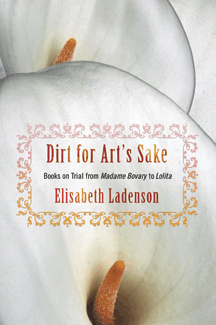Literary censorship from Flaubert to Nabokov.
By Julia M. Klein

DIRT FOR ART’S SAKE:
Books on Trial from Madame Bovary to Lolita
Elizabeth Ladenson C’84.
Cornell University Press, 2007. $29.95.
During the Victorian Age, even the French expressed shock at adultery—in fiction as well as fact. In 1857, the novelist Gustave Flaubert had to go to court to defend the morality of Madame Bovary, his now-classic tale of a bored woman seeking excitement outside her provincial marriage. Flaubert won his case, barely—in part because his protagonist’s suicide allowed him to argue that the novel was reproving adulterous behavior, not promoting it. Still, the judge was condemnatory. “The work in question merits severe blame,” he wrote, “since the mission of literature should be to beautify and enhance the spirit … rather than to inspire disgust for vice …”
Nearly a century later, times had changed. Or had they? When director Vincente Minnelli undertook a film adaptation of Madame Bovary in the late 1940s, he ran up against Hollywood’s infamous Motion Picture Production Code, which, like French society in the Victorian era, frowned on positive depictions of adultery. Minnelli used Flaubert’s trial as the film’s narrative frame—a way of tweaking would-be censors, past and present. But, unlike Flaubert, he had to submit to them by rewriting scenes to make Emma Bovary’s adulteries less justifiable.
This was not a matter of history merely repeating itself, according to Elisabeth Ladenson C’84, who tells both stories in Dirt for Art’s Sake: Books on Trial from Madame Bovary to Lolita. Instead, she writes, “we find history reeling around, grabbing us drunkenly by the collar and repeating itself in such loud and insistent tones that we can only sit back and listen to its incoherent tale.”
By combining cultural analysis with literary criticism, Dirt for Art’s Sake tries to render the tale more coherent. Though lucidly written and largely jargon-free, it assumes a certain degree of sophistication and literary knowledge. And Ladenson’s nonlinear, elliptical approach—she has a tendency to circle back on herself to repeat, deepen, and complicate an argument—is better suited to the classroom than to the bedroom or the beach.
An associate professor of French and comparative literature at Columbia University, Ladenson is well-placed to add Flaubert’s legal troubles and those of Baudelaire—six of whose poems in Les Fleurs du Malwere suppressed in 1857—to the more familiar Anglo-American narrative of literary censorship. The book’s remaining chapters treat James Joyce’s Ulysses, Radclyffe Hall’s The Well of Loneliness, D.H. Lawrence’s Lady Chatterley’s Lover, Henry Miller’s Tropic of Cancer, and Vladimir Nabokov’s Lolita. An epilogue touches on John Cleland’s Fanny Hill and offers a nice précis of the cultural reception of the works (and persona) of the Marquis de Sade.
To Ladenson, “the history of modern literary censorship is rife with irony, paradox, and absurdity”—all fine grist, one is tempted to add, for any good postmodernist’s mill. Animating her inquiry is the question of how books once judged to be obscene are transformed into classics—a question for which Dirt for Art’s Sake provides no single satisfactory answer. After all, as she notes, the books she discusses are hardly equal in aesthetic merit. Ladenson seems most in her element discussing Lolita, in which she finds a mosaic of sly references to authors ranging from Edgar Allan Poe to Dostoevsky, and no backing for any moral interpretation.
Ladenson, in fact, divides her selected authors into three groups: moralists (such as Hall and Lawrence), immoralists (Baudelaire and Sade), and amoralists (Flaubert, Joyce, and Nabokov), for whom moral considerations are irrelevant. Along with developing this typology, she traces changing trends in literary prosecutions and defense strategies. Flaubert, though an exponent of the autonomy of literature, was forced to engage the prosecution on its own terms, arguing (somewhat disingenuously) that his novel only reinforced traditional values. Hall’s groundbreaking depiction of lesbianism was banned despite its lack of explicitness and its tragic ending. Joyce’s frankness about sex and other bodily functions in Ulysses also attracted the censors, even though his novel would never appeal to the supposedly corruptible masses. Lawrence and Miller upped the ante with their explicit sex scenes and earthy language. Nabokov added a high literary gloss to the verboten theme of pedophilia.
Over the years, however, the terrain of the censors shrank. As Western society liberalized, the notion of art for art’s sake and the validity of artistic realism (even when reality was sordid or unpleasant) gained sway. The mid-20th-century American legal standard, promulgated by Supreme Court Justice William Brennan W’28 Hon’57 and later somewhat toughened—that a book needed to be “utterly without redeeming social importance” in order to be banned—made obscenity prosecutions of serious literary works all but impossible.
These days, as Ladenson suggests, free-expression battles are being waged elsewhere. In this country, network television, films seeking mainstream distribution, and even email are all subject to censorship of various sorts. (One might add to this list the family newspaper, as well as most magazines.) This is so, Ladenson argues, even though the notion of transgression has come to be valued in our society—a proposition she asserts without delineating its contours or ramifications. “Our age is all for subversion,” she concludes, abruptly and with just a trace of world-weariness, “as long as the ideas subverted are other than our own.”
Julia M. Klein writes for The New York Times, The Wall Street Journal, Mother Jones, and other publications.




